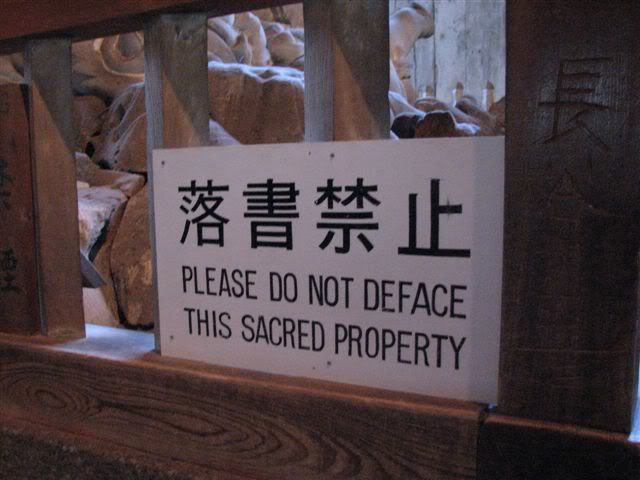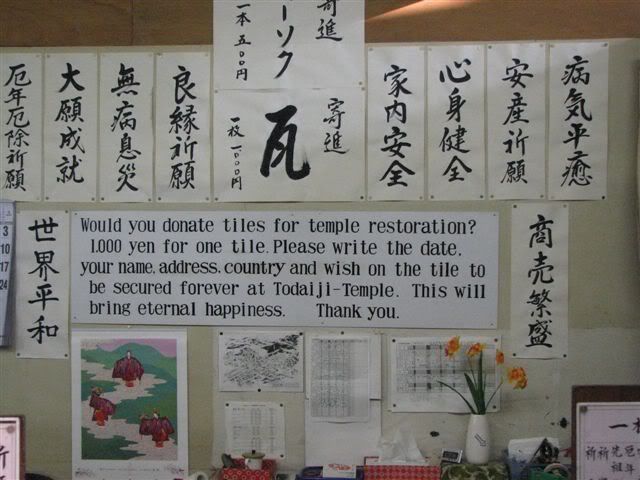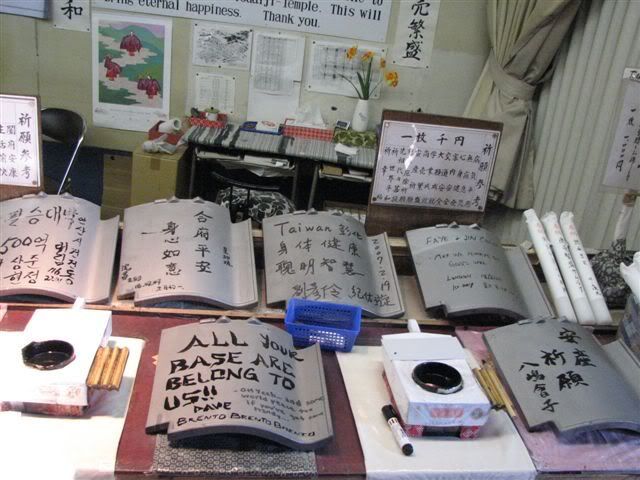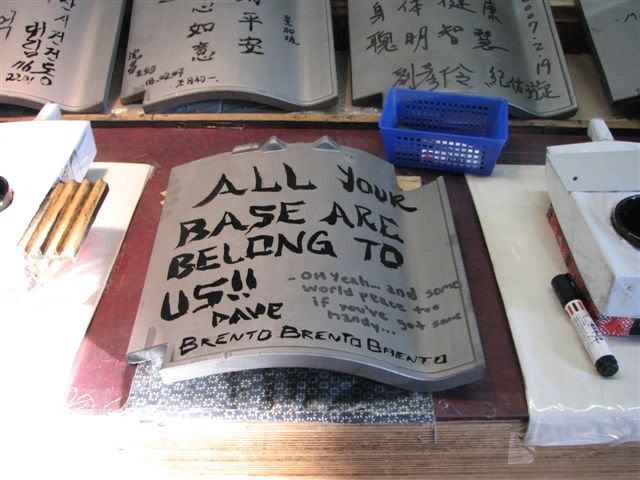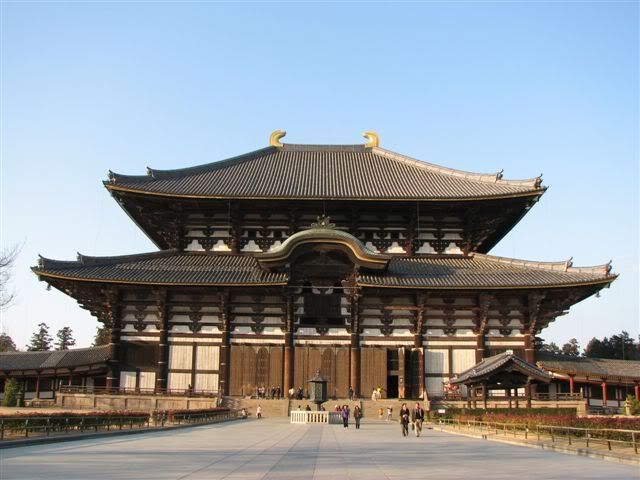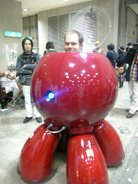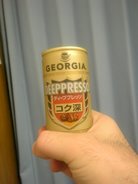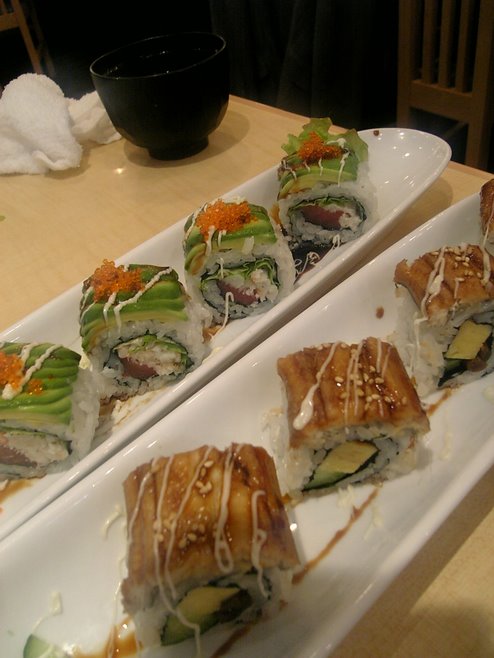One of the side effects to having a lot of adventures is that sometimes the experiences are so jam-packed into a given set of days that the actual recording of them falls into an awful void that I like to call “notes”. Notes are wonderful, and they help you recall the experience, but they still don't provide very good entertainment value for your non-paying but greatly appreciated audience. And, dear audience, you are indeed appreciated. I enjoy crazy adventures, and I enjoy the idea that I can bring a bit of joy into YOUR life.
In any case, I've resolved to steel my resolve, and start putting down all the things I shoulda-woulda-coulda recorded, because it’s been one crazy month. The path has been wild and exciting, and I'm a new man now. You’ll all have to treat it like cable TV though. I've shot the episodes, and several members of the cast know the ending already, but that doesn’t mean that you can’t sit back and enjoy some more of the merry adventures of the Merry Man in Japan.
Without further ado, I present….
A Kyoto Tale, part 1: Japanese Mom(s)The SetupKyoto is arguably one of the most important and interesting places in all of Japan. Not only do they say “osaki-ni” instead of “arigatou gozaimasu” (“thank you”), it happens to also be the famous for a climate change accord, as well as the presence of some, uh…. history. In fact, Kyoto is home to so many cultural treasures that a trip there regularly forces you to ignore several thousand-year-old shrines and as you head for other, more famous thousand-year-old shrines. All in all, it’s an incredible place.
During my various travels, I have definitely come to appreciate the common sense wisdom of “local advice”. People who live in an area are obviously able to point out the little things that make your trip worthwhile. Unfortunately, the locals live...well... at the place to which you are headed. This makes it rather more difficult to randomly run into them as you are planning said trip. This, of course, leaves the next best thing: someone who has been there a whole whack of times.
This leads me to address one of the best things about teaching: the fact that you get to meet a large number of rather wonderful people, all with different interests and experiences. I have several students who have lived long and interesting lives, which means they have a lot of advice to give about everything from child rearing to restaurant choice. One of my students is particularly fond of both dinner parties and the city of Kyoto – two areas of expertise in which she has been quite kind in sharing with me and with my fellow teachers.
Naturally, when it came time to head up to Kyoto, I asked her for some advice. She told me that she would think about it, and then asked me some basic questions (e.g., Did I want to do things as cheaply as possible or was I open to spending a bit more? How many people were going? Did I want to stay in a traditional place? How many days and nights? Are you going to be crazy culturally menacing foreigners? Please don't burn down our cultural heritage....Pretty please?).
It is a strange brew indeed – a combination of national pride, earnest desire to help someone in need, and genuine interest in the subject – but some of my students would go to extraordinary lengths to do things for their teacher (er, me!). I don't want to speculate on the effort involved, but two weeks later this particular student waltzed into class hefting a large folder and a larger smile. Opening it up with a grin, she revealed what amounted to a 1200-picture worthy, three point five day fully guided tour of the historical capital of Japan. She had information packages, maps, sightseeing notes and guidebooks – all of it furiously highlighted and bilingually annotated.
Getting thereTo get us there, she'd found and booked the luxury “Night Dream” bus, which sported extra wide, super reclining seats three abreast – perfect for large 南蛮人 (barbarian/foreigner) butts. If you are ever planning a long distance trip, such as the Tokyo-Kyoto route, and you don’t want to travel on the painful regular bus (5000 yen), but save money over the新幹線Shinkansen (12000 yen), the “Night Dream” buses (8700) are a wonderful compromise. I even managed to refrain from stealing the very comfortable JR slippers and JR blankets that we were thoughtfully provided with.
Upon arrival, we managed to find our way to the Matsuihonkan – the Ryokan (traditional Japanese Hotel) that my pseudo-mother managed to book for us. We were served some delightful tea in the lobby, and given some snazzy chocolates to enjoy while they checked our bags for the day. I strongly recommend this place if you are planning to stay in Kyoto – mainly because the female staff are another group of excessively helpful mother-esque people.
There are a few places in the world that always exhibit the utmost concern for the customer. North Americans might find top notch service at their favourite restaurants or at an upscale men’s tailor, but it’s really hard to comprehend the level of service that the Japanese afford to their guests. In fact, the words “guest”, “customer” and “client” all have the same translation in Japanese. The customer is a “guest”, and is treated as such. A good Ryokan is the pinnacle of this service. To boot: Your room is served by 3 (THREE!) maids.
“It’s like having a Japanese Mom for a day.”Dave was nearly correct when he pointed this out. You see, “maid” might be a bit of a misrepresentation of the staff, as you never actually have to tell them to do anything. Instead, they take care of everything you might want, and then some. They are kind of like Moms, that is if your Mom never told you to clean your room, but instead did it for you with a waaaay bigger smile than any Mom ever had while picking up someone else’s crap.
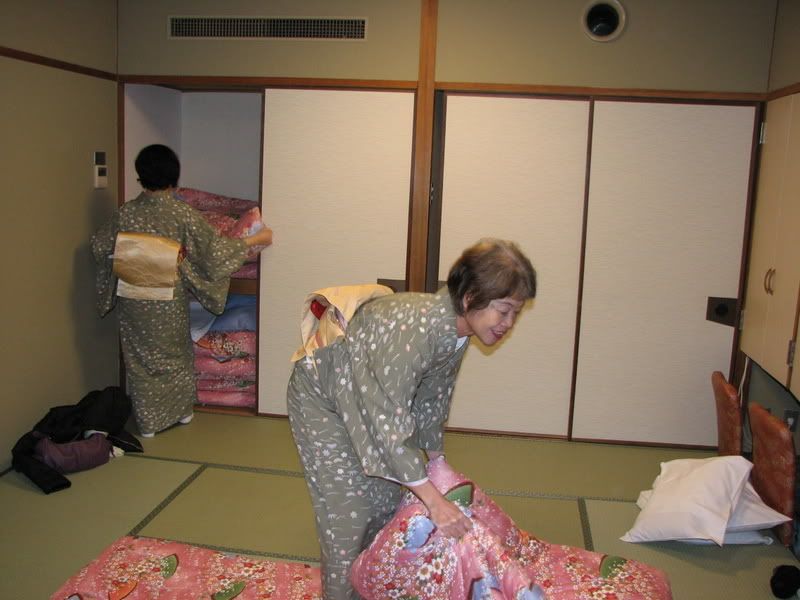
We’ll call them Mom #2, #3 and #4 respectively. (#1 being my student.)
After we arrived, Mom #2 and Mom #3 led us to our room and made sure that it was stocked with sweets and a fresh order of delicious tea. They laid out traditional Japanese Robes, and pointed out useful things like towels, the bathroom, comfy robes, and the window (helpful!)

They also sneakily grabbed our shoes out of the entrance room and CLEANED them.
I was a huge fan of Mom #4 (not pictured above), because she spoke English reasonably well. By "reasonably", I mean she could definitely fulfill all of the duties of a Ryokan maid in English, but her intonation left something bit lacking: She seemed to be unable to form the intonation for a question - all of her sentences ended up sounding more like orders.
"I'LL BRING YOUR DINNER UP AT FOUR, WON'T I!!!"
"YOU WANT A WAKE UP CALL!."
"I WILL NOW PREPARE YOUR BEDS. BE COMFORTABLE.".
Later on they brought a glorious feast, which fulfills the evil, secret purpose of the Ryokan: to generate as many dirty dishes as possible. To this end, they serve a wonderful spread of delicious food on so many little plates that they need several trays per person to bring them all in.
Pictures speak louder than words, I believe.
.JPG)
We definitely showed suitable respect for the effort put into dishware variety.
.JPG) Every hotel needs a Sento.
Every hotel needs a Sento.After dinner, a trip down to the Sento is essential. A Sento is a communal Japanese Bath, spiritually similar to the natural hotsprings (Onsens). A sento doesn’t have naturally heated mineral water, but it’s still incredibly relaxing. To those of you who are unfamiliar, it’s basically like a giant public bathtub surrounded by sitting showers. The sitting-shower took some time to get used to at first, but after you’ve come to terms, you realize that you can clean certain things better if you can reach them (for example FEET, you filthy people). After scrubbing yourself, you jump into a super hot bath, and you can engage in pleasant semi drunken late night philosophy. After all, few things build rapport like mutual nudity and intellectual interest. I know Plato would have loved it.
I couldn't really take a camera into the bath, as that would have destroyed but I can certainly show you how relaxed one feels AFTER consuming booze, soaking in a hot tub, and retiring to bed in a lovely yukata/robe...
 Up next: choosing the best 1000 year old shrine complex.
Up next: choosing the best 1000 year old shrine complex. Japanese Notes: 南蛮人 “Nambanjin”... literally “southern barbarian”. This is my favourite Edo era word for foreigners. 外人 (Gaijin) is actually somewhat offensive, and 外国人 (Gaikokujin) is nowhere near as funny.

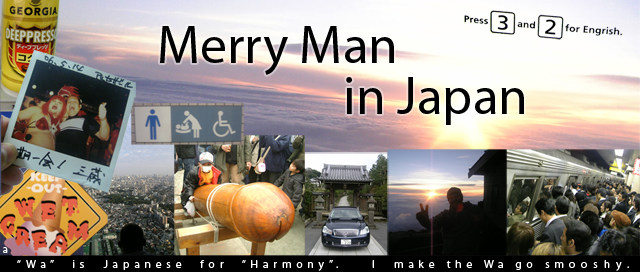


.JPG)
.JPG)

